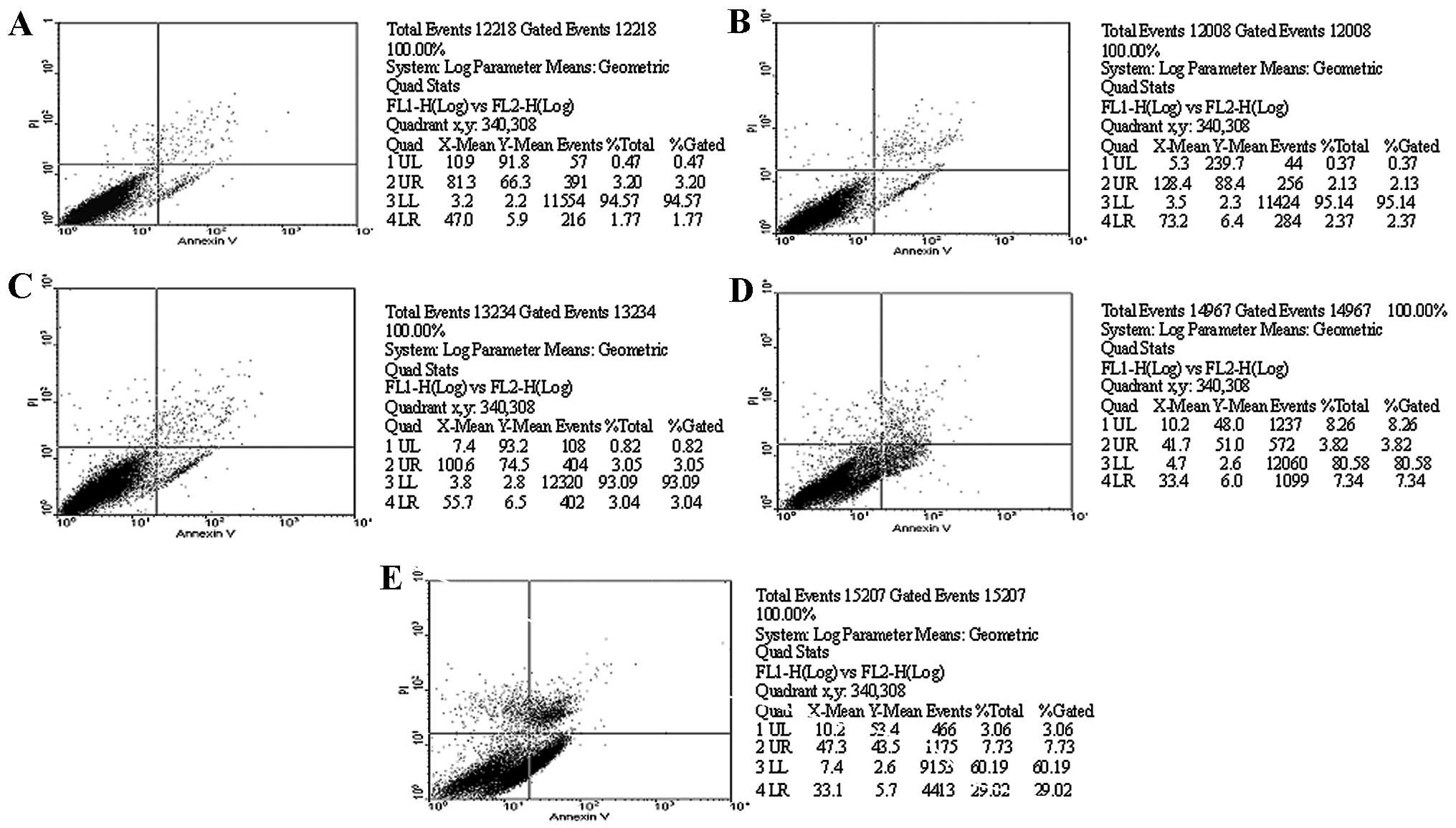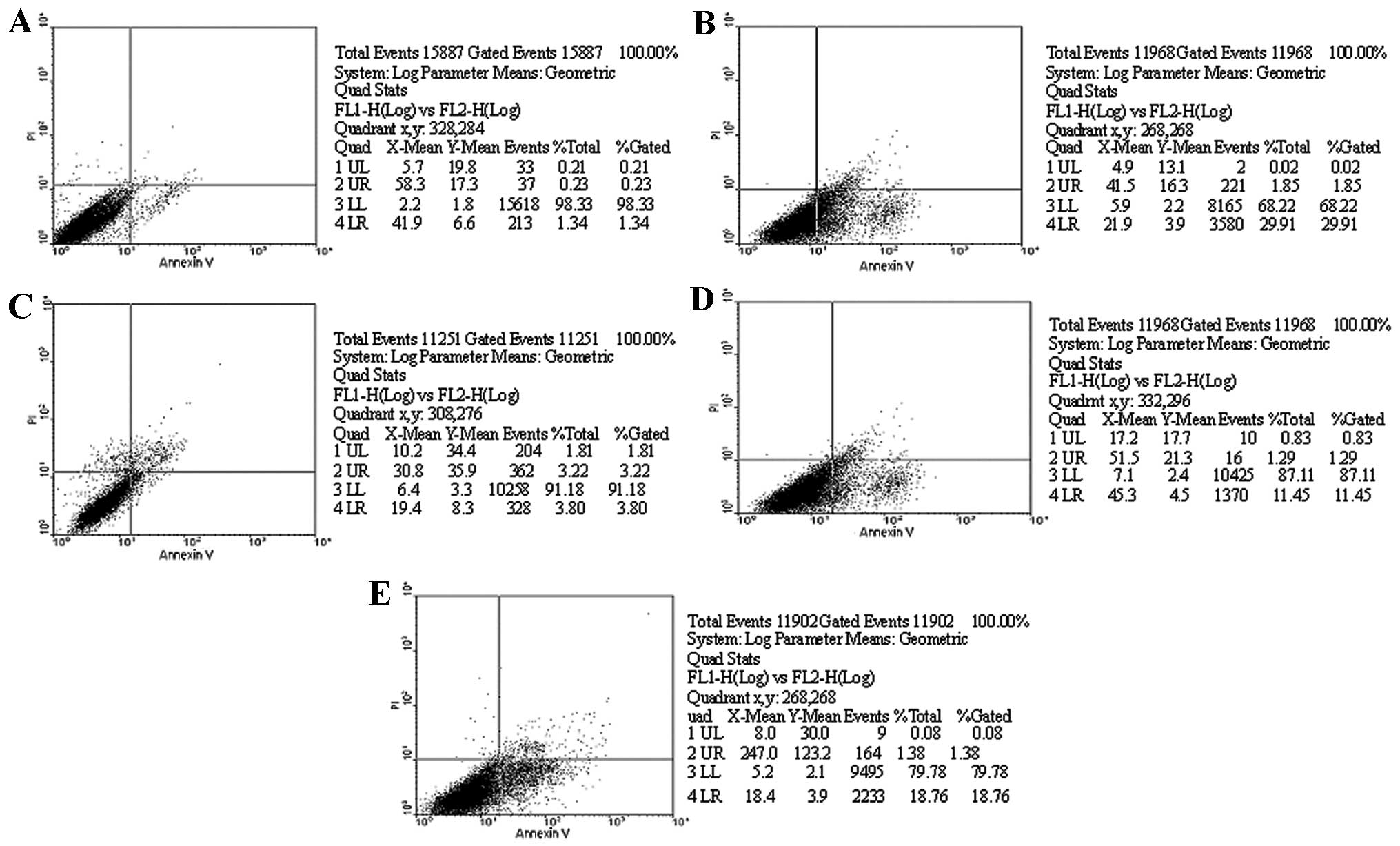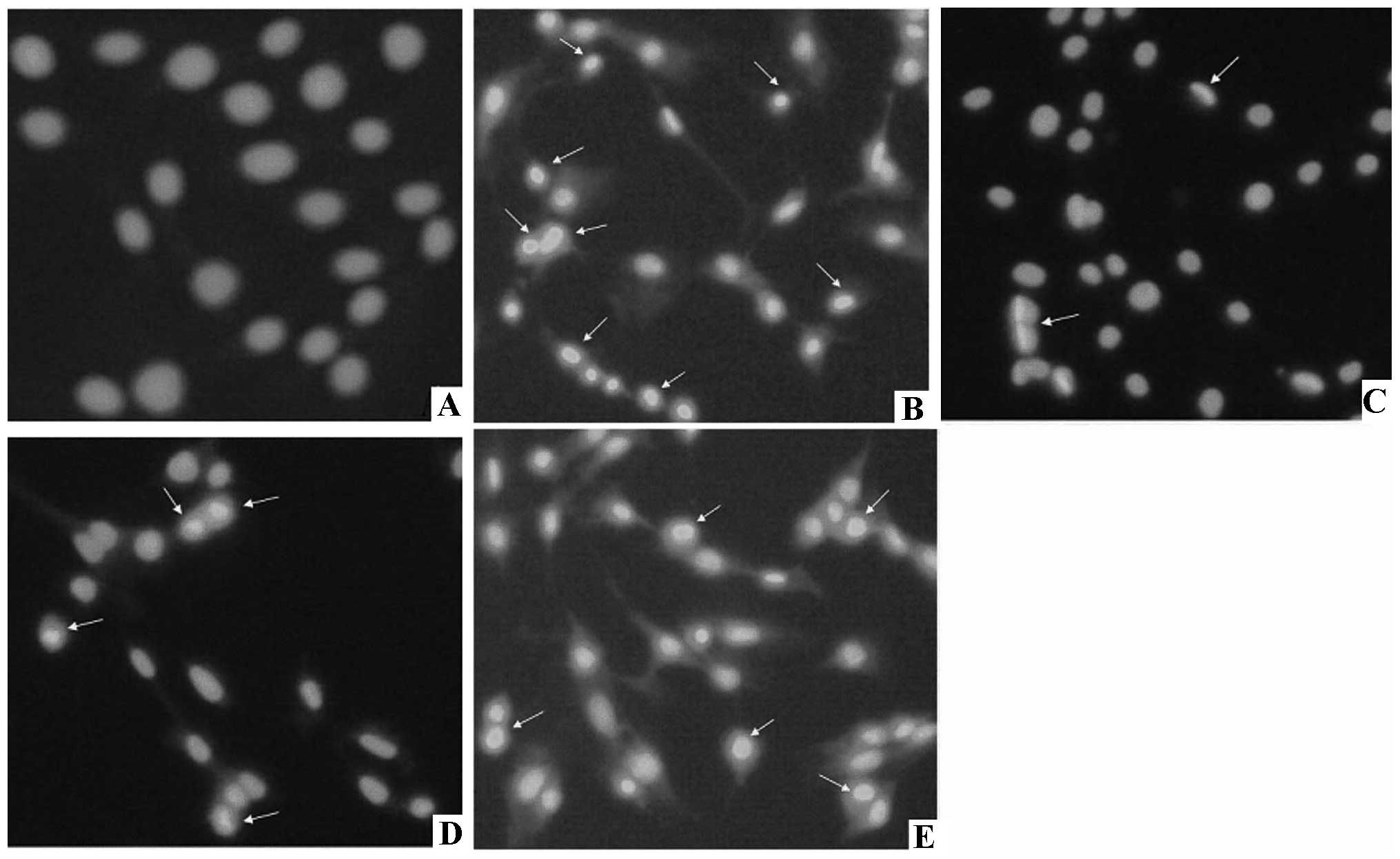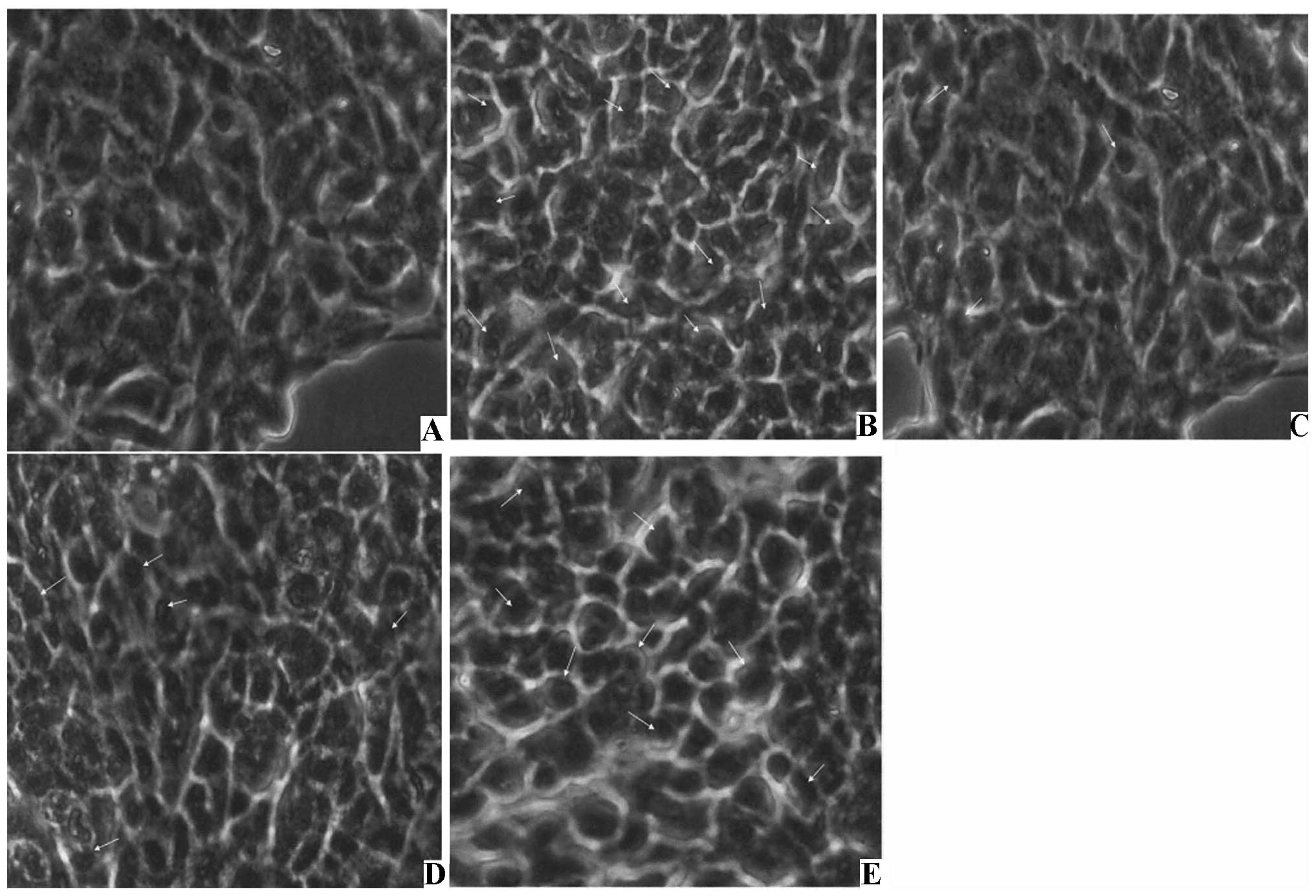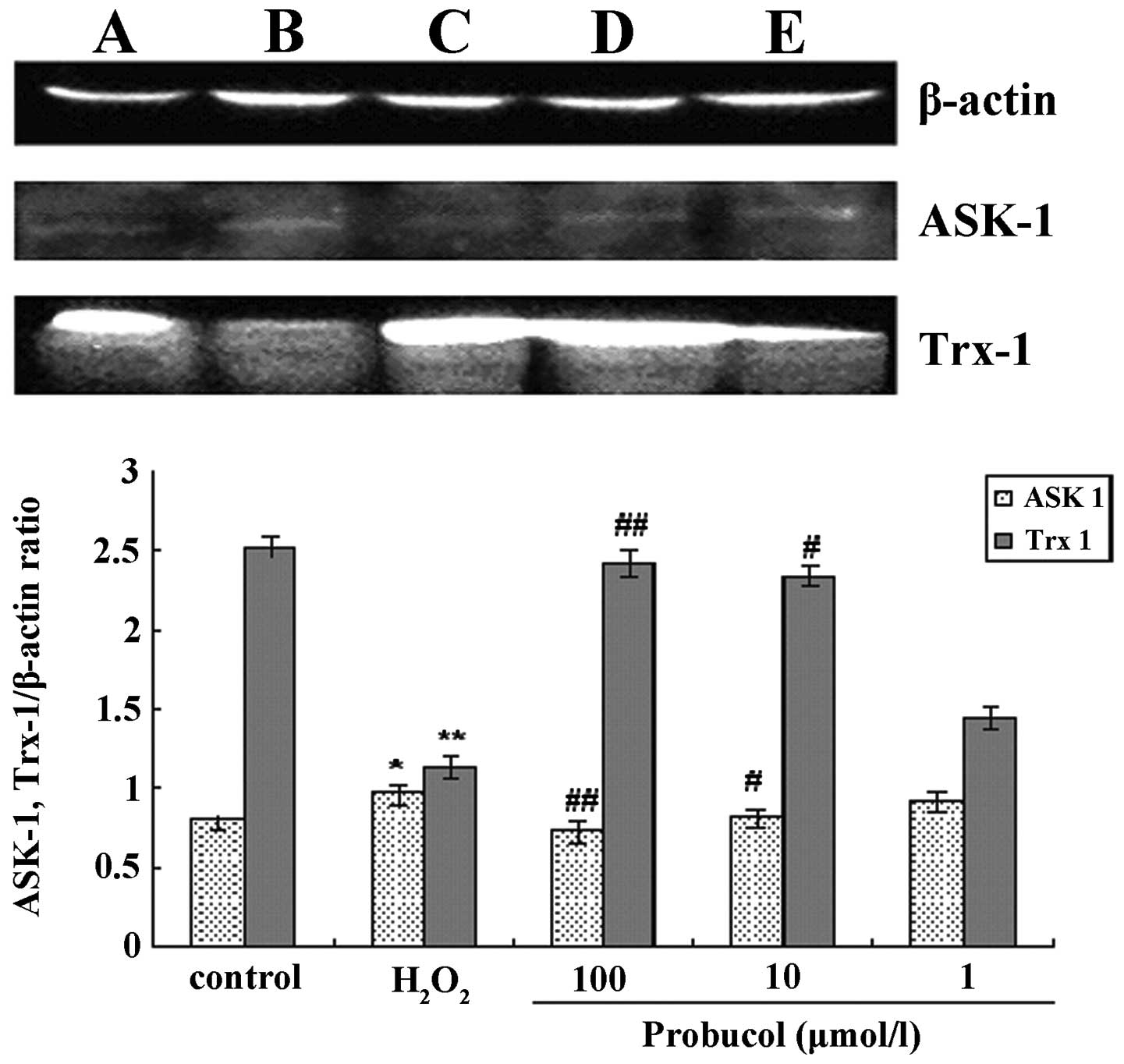Probucol inhibits hydrogen peroxide to induce apoptosis of vascular smooth muscle cells
- Authors:
- Published online on: January 29, 2013 https://doi.org/10.3892/mmr.2013.1299
- Pages: 1185-1190
Abstract
Introduction
Atherosclerosis (AS) plaque cell apoptosis is the main factor leading to plaque instability (1–3). Cell apoptosis occurs in various periods of AS damage. Apoptotic cells in the plaque are mainly vascular smooth muscle cells (VSMCs) and macrophages. Excessive VSMC proliferation and apoptosis constitute the main pathological basis of AS plaque formation, which has a significant impact on the development and outcome of AS (3,4). AS plaque formation depends on the relative balance of apoptosis and proliferation of VSMCs. Cell proliferation is dominant in the early period of AS. With progression of AS, particularly in the late stage, VSMC apoptosis directly affects the arterial shape and structure, and increases the plaque instability. This is the major factor causing clinical manifestations (5). Thus, preventing apoptosis of VSMCs in late-stage AS would have a positive impact in preventing the occurrence of serious clinical AS complications.
As the knowledge of the importance of oxidative stress and oxidized low density lipoprotein in the pathogenesis of AS has increased, experimental reports on probucol inhibition of AS progression, promotion of regression of the AS plaque, and prevention of restenosis following interventional therapy have been increasing (6–8). The correlation between probucol and inflammatory mediators, endothelial function, cytokines, antioxidant enzymes, particularly the correlation between intracellular signaling proteins and transcription factor activity on VSMC proliferation and apoptosis, and the role in the AS pathophysiology, has become a hot topic of research in recent years (7,9,10). Previous studies confirmed that by maintaining intracellular redox balance, probucol reduced intracellular GSH consumption and inhibited H2O2-induced apoptosis in VSMCs (11). In the process of apoptosis, Trx-1 and ASK-1 associated with MAPK pathways also play an important role. Whether the anti-apoptotic effects of probucol are related to these factors has not been reported. In this study, H2O2 was used as an apoptosis-inducing agent, and we observed the effect of probucol on VSMC apoptosis and Trx-1 and ASK-1 expression, and explored its anti-apoptotic mechanism.
Materials and methods
Animals
Healthy Wistar rats, male, clean and weighing 171±18 g, were provided by the Experimental Animal Center of Shandong University. The study was approved by the College of Environmental and Chemical Engineering, Nanchang University, Nanchang, Jiangxi, P.R. China.
VSMC culture
VSMCs were cultured using the tissue attached method. Rat thoracic aorta was obtained, the vascular adventitia was stripped, the endometrium was removed, cut into lx1 mm tissue slices and attached to the culture bottle, cultured at 37°C in 5% CO2 conditions containing 20% fetal calf serum DMEM medium, and the medium was changed once every 3–5 days. When the cells grew to be 60–80% confluent, 0.25% trypsin was added for digestion and cells were passaged at 4–6 days. Cells were spindle-shaped, and the typical ‘peak-valley’-like structure appeared when they grew into a dense layer. VSMCs of passage 3–8 were used in this experiment.
Flow cytometry
VSMCs were digested with 0.25% trypsin, adjusting the cell concentration to 2×107 cells/l density and seeded in 96-well culture plates. The cells were divided into a control group, a model group (1 mmol/l H2O2,), and probucol 1, 10, 100 μmol/l groups. After 24 h of culture at 37°C in a 5% CO2 incubator, H2O2 and probucol were added and the cells were cultured for 6 h. The medium was then discarded, cells were washed with PBS and dispersed into single cells following digestion with 0.25% trypsin protease. The cell suspension (0.5–1×106/ml) was washed twice with PBS, centrifuged at 2000 rpm/min for 5 min, the supernatant was discarded and 100 μl binding buffer and 10 μl FITC-labeled Annexin V (20 μg/ml) were added. The samples were kept in the dark at room temperature for 30 min, then 5 μl PI (50 μg/ml) was added, the samples were reacted in the dark for 5 min, 400 μl binding buffer was added, and the cells were immediately detected by flow cytometry using FACScan. Samples without Annexin V-FITC and PI were used as the negative control. Cell apoptosis was analyzed using WinMDI29 image processing software. The effects of different concentrations of probucol treatment on the apoptosis rate of VSMCs were observed.
TUNEL staining
The cell groups mentioned previously were cultured in 6-well plates (built-in cover glass). The coverslips inoculated with cells were taken and stained according to the TUNEL labeling staining kit instructions and observed under the microscope. The nuclei that appeared brown were positive. Four slides were observed, each at ×200 magnification, in order to calculate the apoptosis index (AI). AI represented the percentage of the number of positive cells and the total cell number in five views selected from each slide.
Hoechst 33258 staining
The cultured cells were taken, washed with PBS and fixed for 10 min. Cells were washed with PBS, and stained with Hoechst 33258 dye at room temperature for 10 min. After washing with PBS, excess liquid was absorbed, cells were mounted under a fluorescence microscope, and the morphological changes of the cells were observed.
Western blot analysis
After the cells were collected and washed three times with iced PBS, lysed by adding an appropriate amount of lysate in ice bath conditions and centrifuged at 12000 rpm for 15 min, the supernatant was carefully drawn, and the protein concentration was determined using the BCA method. Protein samples (40 μg) were taken, ASK-l proteins were separately run on 10% SDS-PAGE gels, and Trx-1 on 15% SDS-PAGE gels (laminated plastic 80 mV, gel 120 mV), then electrophoretically transferred (150 mA, 1.5 h) to a PVDF membrane, blocked using 5% non-fat dry milk for 1 h, and incubated with rabbit anti-ASK-1 (1:100) and Trx-1 (1:100) polyclonal antibodies overnight at 4°C. After washing with TBST three times, l:1000 concentrations of second antibody were added for l h. After washing with TBST three times, the membranes were evenly coated with the same amount of chemiluminescence A and B solution and underwent electrochemiluminescence immunoassay (ECL) for 5 min. A GIS image processing system was used for analysis.
Statistical analysis
SPSS 15 statistical software was used for analysis, and data were shown with the means ± SD. Sample means were compared using analysis of variance and the LSD pairwise comparison method.
Results
VSMC apoptosis
As shown in Table I, H2O2 had marked effects on the VSMC apoptosis rate. Flow cytometry analysis showed that VSMC apoptosis was significantly increased by 23.9±5.8% after cells were treated with H2O2 for 6 h. Compared with the H2O2 group, the probucol group significantly inhibited H2O2-induced apoptosis, and the apoptotic rates were 3.8±2.8% in the 100 μmol/l group (P<0.01), 11.3±4.1% in the 10 μmol/l group (P<0.05) and 16.8±4.5% in the 1 μmol/l, showing a concentration-dependent effect (Figs. 1 and 2). Hoechst 33258 staining showed that nuclear condensation occurred in the H2O2 treatment group. A compact fluorescent stain was observed in the nucleus and cytoplasm, with a deep and bright color. Hoechst 33258 staining showed that nuclear condensation occurred in the H2O2 treatment group. A compact fluorescent stain was observed in the nucleus and cytoplasm (Fig. 3). Compared to control (1.46±0.82%), VSMC apoptosis rates for the H2O2 group, and the 100, 10, 1 μmol/l probucol groups were 29.57±5.81, 3.50±1.54, 12.36±4.10 and 17.96±2.81%, respectively (Table II). The TUNEL assay revealed that apoptotic nuclei were brown in color, had nuclear condensation, the chromatin condensed into a cluster, and showed a strong positive change (Fig. 4, Table III). The AI in the control group was 3.22±1.12%, in the H2O2 group it was 28.28±5.24%, in the 100 μmol/l probucol group it was 4.58±1.27% (P<0.01 compared with the H2O2 group), in the 10 μmol/l it was 11.38±2.46% (P<0.05 compared with the H2O2 group), and in the 1 μmol/l group it was 18.33±3.24%.
Table IIEffect of different concentrations of probucol on H2O2-induced VSMC apoptosis (Hoechst 33258 staining) (mean ± SD, n=4). |
Table IIIEffect of different concentrations of probucol on H2O2-induced VSMC apoptosis (TUNEL method) (mean ± SD, n=4). |
ASK-1 and Trx-1 protein expression
After VSMCs were treated with 1 mmol/l H2O2 the ASK-1 protein expression was significantly increased and Trx-1 protein expression decreased, compared with the control group. Probucol treatment is capable of reducing the ASK-1 protein expression and increasing Trx-1 expression (Fig. 5, Table IV).
Table IVEffects of different concentrations of probucol on the expression of ASK-1 and Trx-1 in VSMCs stimulated by H2O2 (mean ± SD, n=4). |
Discussion
Oxidative stress is considered to be a major factor that causes VSMC damage. Reactive oxygen species (ROS) play an important role in mediating the process of vascular wall apoptosis (12,13). As they constitute the vessel wall structure and are the major cellular components in the maintenance of vascular tone, VSMCs are important in AS. Under many pathological conditions, both oxidized low-density lipoprotein (ox-LDL)-induced VSMC apoptosis and VSMC proliferation stimulated by high glucose, ROS are important mediating factors (14–16). ROS are capable of altering the intracellular redox balance, activating the redox-sensitive signaling protein kinases and transcription factors, and inducing apoptosis and proliferation through different signal transduction pathways (15,17–19). Therefore, the redox state of equilibrium formed by the molecular oxidation and reduction reactions will have a decisive role in VSMC proliferation or apoptosis, and thus affect vascular disease development and prognosis. The intracellular thioredoxin and glutathione (GSH) systems constitute the most two important reduction systems. The thioredoxin system consists of NADPH, thioredoxin reductase (TrxR) and Trx. Trx-1 is located in the cytoplasm, which is characterized by the surface of the protein molecules having a Trp-Cys-Gly-Pro-Cys-Lys structure, two of which may be oxidized to form a Cys reversible disulfide bridge, and re-reducted by the TrxR with NADPH participation. Trx activity was capable of reducing the SS bridge exposed on the transcription factor surface and keeping the reduction state and restoring the transcription factor activity. Trx-1 has anti-apoptotic activity. ASK-1 is activated by cytokines and stress stimuli factors. By activating c-Jun NH2-terminal kinase (JNK) and p38MAPK, cell apoptosis is induced (13,20,21). Trx-1 is the main regulatory factor of ASK-1 that functions through the oxidation of the Trx active site Trp-Cys-Gly-Pro-Cys-Lys structure. ROS cause the two cysteines to form intramolecular disulfide bonds, form the oxidized Trx, separate Trx and ASK-1, and free ASK-1 induces apoptosis through the JNK/p38MAPK pathway (21,22).
H2O2 is one of the most important ROS signal transduction molecules. It can induce apoptosis of many types of cells, and can also be used as an extracellular second messenger of stimulating factors involved in the process of intracellular signal transduction that induce apoptosis (20,23). H2O2 may induce apoptosis through a number of different signaling pathways. H2O2 is capable of enhancing mitogen-activated protein kinases (MAPKs), mainly through c-Jun N-terminal kinase (JNK) and p38 MAPK. However, the non-extracellular signal-regulated protein kinase (ERK) pathway induced VMSC apoptosis (24). H2O2 is capable of activating the mitochondrial fusion protein 2 (Mitofusin 2, Mfn-2), which can reduce the phosphorylation of Akt and inhibit its anti-apoptotic activity, and increase the mitochondrial Bax/Bcl-2 ratio, cytochrome C release, and activation of caspases-9 and caspase-3 signaling pathway-induced VSMC apoptosis (25). ASK-1 is a mitogen-activated protein kinase kinase family member. ASK1 activity depends on the interaction of the N-terminal homology (N-terminal homophilic interaction). Studies have shown that after a reduction in Trx, tumor necrosis factor receptor-associated factor (TRAF) combining with ASK-1, the ASK-1 N-terminal coiled-coil domain could adjust its N-terminal homology interactions (N-terminal homophilic interaction) and thereby affect ASK-1 function (26). By inhibiting the interaction of the N-terminal homology functional activity, Trx inhibits ASK-1, while H2O2, TRAF2 and TRAF6 enhanced ASK-1 activity through interactions between the N-terminal homology. However, at present, H2O2-induced VSMC apoptosis and the reports on the correlation of Trx-1 with ASK-1 have remained relatively limited.
Probucol is a chain breaking antioxidant; its structure consists of two butyl-hydroxy toluene parts, and it can be used as a single electron donor and singlet oxygen scavenger to remove oxygen free radicals within cells. In addition, probucol can decrease oxidative lipid and cholesterol levels, and reduce the lipid necrotic core area, causing AS plaque stabilization and anti-restenosis (6–8,27). Probucal is recognized to have antioxidant mechanisms, and acts on ox-LDL and against ischemia-reperfusion injury-induced apoptosis (28,29). The method by which probucol inhibits apoptosis signal regulating mechanisms has not yet been fully understood. Recent studies have shown that probucol significantly reduced p53, Bax and caspase-3 mRNA expression, and enhanced Bcl2 mRNA expression and resistance to apoptosis (30,31). However, whether the effect of probucol against VSMC apoptosis is related to ASK-1 and Trx-1 has not been reported. This study shows that different concentrations of H2O2 are capable of inducing VSMC apoptosis in a dose-dependent manner. High concentrations (1000 μmol/l) of H2O2 led to a large amount of VSMC apoptosis (apoptotic rate of 29.57%). Probucol could cause significant resistance to H2O2-induced VSMC apoptosis in a dose-dependent manner; 100 μmol/l probucol is capable of reducing the H2O2-induced VSMC apoptosis to significantly near to the control group level (1.46±0.82 vs. 3.50±1.54). Probucol increased Trx-1 expression that was significantly downregulated by the H2O2, while ASK-1 expression was significantly reduced in a dose-dependent manner. Thus, probucol inhibition of ROS-induced apoptosis of VSMCs may be related to ASK-l and Trx-1, indicating that increased Trx-1 levels and increased levels of Trx-1-ASK-1 complexes may be the mechanism of probucol inhibition of ROS-induced apoptosis of VSMCs, but the detailed mechanism remains to be studied.
References
|
Liu N and Liu JT: Anoikis in rapture of atherosclerotic plaque. Chin Pharmacol Bull. 23:298–301. 2007. | |
|
Clarke MC, Littlewood TD, Figg N, et al: Chronic apoptosis of vascular smooth muscle cells accelerates atherosclerosis and promotes calcification and medial degeneration. Circ Res. 102:1529–1538. 2008. View Article : Google Scholar | |
|
Rudijanto A: The role of vascular smooth muscle cells on the pathogenesis of atherosclerosis. Acta Med Indones. 39:86–93. 2007.PubMed/NCBI | |
|
Boyle JJ: Macrophage activation in atherosclerosis: pathogenesis and pharmacology of plaque rupture. Curr Vasc Pharmacol. 3:63–68. 2005. View Article : Google Scholar : PubMed/NCBI | |
|
Stoneman VE and Bennelt MR: Role of apoptosis in atherescleresis and its therapeutic implications. Clin Sci (Lond). 107:343–354. 2004. View Article : Google Scholar : PubMed/NCBI | |
|
Ko YG, Kim BK, Lee BK, et al: Study design and rationale of "Synergistic effect of combination therapy with cilostazol and ProbUcol on plaque stabilization and lesion REgression (SECURE)" study: a double-blind randomised controlled multicenter clinical trial. Trials. 12:102011. View Article : Google Scholar | |
|
Kaminnyi AI, Lankin VZ, Samko AN, et al: Low daily dose of antioxidant probucol decreases incidence and severity of restenosis after transluminal coronary balloon angioplasty. Bull Exp Biol Med. 139:183–185. 2005. View Article : Google Scholar : PubMed/NCBI | |
|
Wu BJ, Kathir K, Witting PK, et al: Antioxidants protect from atherosclerosis by a heme oxygenase-1 pathway that is independent of free radical scavenging. J Exp Med. 203:1117–1127. 2006. View Article : Google Scholar : PubMed/NCBI | |
|
Kyaw M, Yoshizumi M, Tsuchiya K, et al: Atheroprotective effects of antioxidants through inhibition of mitogen-activated protein kinases. Acta Pharmacol Sin. 25:977–985. 2004.PubMed/NCBI | |
|
Choy K, Beck K, Png FY, et al: Processes involved in the site-specific effect of probucol on atherosclerosis in apolipoprotein E gene knockout mice. Arterioscler Thromb Vasc Biol. 25:1684–1690. 2005. View Article : Google Scholar : PubMed/NCBI | |
|
Sheng L, Pan QX, Liu YJ, et al: Prevention of probucol against H2O2 induced apoptosis in rat vascular smooth muscle cells. Acts Acad Med Shandong. 39:370–372. 2001. | |
|
Irani K: Oxidant signaling in vascular cell growth, death and survival. Circ Res. 87:179–187. 2000. View Article : Google Scholar : PubMed/NCBI | |
|
Yamawaki H, Haendeler J and Berk BC: Thioredoxin: A Key Regulator of Cardiovascular Homeostasis. Circ Res. 93:1029–1033. 2003. View Article : Google Scholar : PubMed/NCBI | |
|
Hsieh CC, Yen MH, Yen CH and Lau YT: Oxidized low density lipoprotein induces apoptosis via generation of reactive oxygen species in vascular smooth muscle cells. Cardiovasc Res. 49:135–145. 2001. View Article : Google Scholar : PubMed/NCBI | |
|
Schauer IE, Knaub LA, Lloyd M, et al: CREB downregulation in vascular disease: a common response to cardiovascular risk. Arterioscler Thromb Vasc Biol. 30:733–741. 2010. View Article : Google Scholar : PubMed/NCBI | |
|
Sharpe PC, Yue KK, Catherwood MA, McMaster D and Trimble ER: The effects of glucose-induced oxidative stress on growth and extracellular matrix gene expression of vascular smooth muscle cells. Diabetologia. 41:1210–1219. 1998. View Article : Google Scholar : PubMed/NCBI | |
|
Satoh K, Nigro P and Berk BC: Oxidative stress and vascular smooth muscle cell growth: a mechanistic linkage by cyclophilin A. Antioxid Redox Signal. 12:675–682. 2010. View Article : Google Scholar : PubMed/NCBI | |
|
Touyz RM: Reactive oxygen species and angiotensin II signaling in vascular cells -- implications in cardiovascular disease. Braz J Med Biol Res. 37:1263–1273. 2004. View Article : Google Scholar : PubMed/NCBI | |
|
Paravicini TM and Touyz RM: Redox signaling in hypertension. Cardiovasc Res. 71:247–258. 2006. View Article : Google Scholar | |
|
Takeda K, Matsuzawa A, Nishitoh H and Ichijo H: Roles of MAPKKK ASK1 in stress-induced cell death. Cell Struct Funct. 28:23–29. 2003. View Article : Google Scholar : PubMed/NCBI | |
|
Song JJ and Lee YJ: Differential role of glutaredoxin and thioredoxin in metabolic oxidative stress-induced activation of apoptosis signal-regulating kinase1. Biochem J. 373:845–853. 2003. View Article : Google Scholar : PubMed/NCBI | |
|
Watson WH, Yang X, Choi YE, Jones DP and Kehrer JP: Thioredoxin and its role in toxicology. Toxicol Sci. 78:3–14. 2004. View Article : Google Scholar | |
|
Qian ZQ, Zeng YY, Wang T, et al: VEGF induces HUVECs to produce extracellular H2O2 and its proliferation role. Chin J Pathophysiology. 23:533–535. 2007. | |
|
Tsujimoto A, Takemura G, Mikami A, et al: A therapeutic dose of the lipophilic statin pitavastatin enhances oxidant-induced apoptosis in human vascular smooth muscle cells. J Cardiovasc Pharmacol. 48:160–165. 2006. View Article : Google Scholar | |
|
Guo X, Chen KH, Guo Y, et al: Mitofusin 2 triggers vascular smooth muscle cell apoptosis via mitochondrial death pathway. Circ Res. 101:1113–1122. 2007. View Article : Google Scholar : PubMed/NCBI | |
|
Fujino G, Noguchi T, Matsuzawa A, et al: Thioredoxin and TRAF family proteins regulate reactive oxygen species-dependent activation of ASK1 through reciprocal modulation of the N-terminal homophilic interaction of ASK1. Mol Cell Biol. 27:8152–8163. 2007. View Article : Google Scholar | |
|
Yang YB, Liao DF, Xie ZZ and Huang HL: Probucol prevention against restenosis by regulating functional vascular remodeling after percutaneous transluminal angioplasty in rabbits. Chin Pharmacol Bull. 19:388–392. 2003. | |
|
Su B, He H, Luo QF, Zu BY and Liao DF: Effects of probucol on ox-LDL induced apoptosis and CD36, Caveolin-1 expression in THP-l macrophages. Chin Pharmacol Bull. 23:1167–1171. 2007. | |
|
Ruixing Y, Al-Ghazali R, Wenwu L and Jinzhen W: Pretreatment with probucol attenuates cardiomyocyte apoptosis in a rabbit model of ischemia/reperfusion. Scand J Clin Lab Invest. 66:549–558. 2006. View Article : Google Scholar : PubMed/NCBI | |
|
Asiri YA: Probucol attenuates cyclophosphamide-induced oxidative apoptosis, p53 and Bax signal expression in rat cardiac tissues. Oxid Med Cell Longev. 3:308–316. 2010. View Article : Google Scholar | |
|
Tang X, Yang X, Peng Y and Lin J: Protective effects of lycopene against H2O2-induced oxidative injury and apoptosis in human endothelial cells. Cardiovasc Drugs Ther. 23:439–448. 2009. View Article : Google Scholar : PubMed/NCBI |



